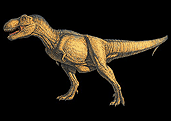Jack Horner
Updated February 21, 2017 | Factmonster Staff 

John R. "Jack" Horner
Paleontologist
Starting at an Early Age
Jack Horner, one of the America's best-known paleontologists, discovered his first dinosaur fossil when he was eight years old. Born in Shelby, Montana, on June 15, 1946, Horner has made some of the most important recent dinosaur discoveries, written several books about his discoveries and theories, and served as a technical adviser for such movies as Jurassic Park, The Lost World (Jurassic Park II), and Jurassic Park III.
While he was not always the best student—he would later discover that many of his academic difficulties were the result of undiagnosed dyslexia—Horner always excelled at science, saying that his brain worked best when it could "hunt, poke, and dig-around." It was through digging around that Horner made his first great discovery.
While he was not always the best student—he would later discover that many of his academic difficulties were the result of undiagnosed dyslexia—Horner always excelled at science, saying that his brain worked best when it could "hunt, poke, and dig-around." It was through digging around that Horner made his first great discovery.
Thanks Mom, You're the Best
In the mid-1970s Horner and fellow paleontologist Bob Makela discovered what appeared to be a large number of dinosaur nests containing the fossils of a duckbilled dinosaur in north-central Montana's Egg Mountain. Horner and Makela named the new dinosaur Maiasaura, which means "good mother lizards," after examining the nests and the remains of dinosaur eggs they found inside. Horner observed a number of interesting characteristics about the nests. The even spacing between the nests and trampled eggshells within suggested that the nests were part of an organized colony, not the result of nesting in a different spot each year. He also determined that there would have been a lack of vegetation in the area of the nests. Using this clue, Horner theorized that the mother dinosaurs found food elsewhere and brought it back to their young while they cared for them in the nest—the first evidence of parental care by dinosaurs.
More Eggs and a New Kind of Dinosaur
Horner's next discovery came in 1988 while working with anatomist David Weishampel when they found more dinosaur eggs in Montana. The unhatched eggs, estimated to be 75 million years old, contained fossilized skeletons of dinosaur embryos. In addition to finding more of the Maiasaura, the eggs also contained a previously unknown kind of dinosaur. The named it Orodromeus, which means "mountain runner," because this dinosaur appears to have stood on two legs, matured rapidly, and to have been capable of searching for food on its own shortly after being hatched.
Move over Sue, the King has Arrived
Most recently, Horner has been credited with discovering the largest Tyrannosaurus rex (T. rex) to date. Estimated to have once weighed between ten and thirteen tons (22,000–28,600 lbs.), it is substantially larger than Tyrannosaurus Sue, and has also produced many new theories on the ways that these creatures lived. Most interestingly, the T. rex was discovered with five other T. rex fossils which indicates that they may have been moving as a pack when they died. This has led Horner to suggest that perhaps this "King of the Dinosaurs" was really more of a scavenger than a predator. His latest research has been on this topic. While other paleontologists are interested in finding new kinds of dinosaurs, he is more interested in analyzing as many of the fossils from the T. rex site as possible to try and learn more about T. rex's everyday behavior.
A New Generation of Scientists
Jack Horner currently serves as the curator of paleontology at Montana's Museum of the Rockies at Montana State University at Bozeman, where he also teaches. When he is not digging up fossils, publishing his discoveries, or producing TV series, he can be found teaching children to appreciate science. He challenges children to argue with him about his ideas and to seek out evidence to support their arguments. He explains, "Science is a process. It is not a body of knowledge." He also believes, "The most important thing you can do is to teach children that it's just as OK to be wrong as it is to be right because you never know if you're right."
See also:

